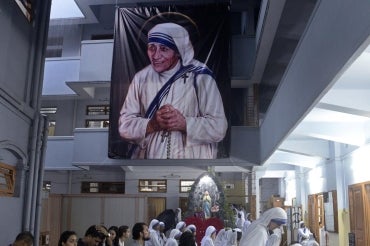The personal encounter is important: U of T’s Reid Locklin on the canonization of Mother Teresa

Published: September 12, 2016
More than 100 000 people gathered in St. Peter’s Square last Sunday to hear Pope Francis’ proclamation that Mother Teresa had been canonized as Saint Teresa of Kolkata. The cause for her canonization was led by none other than U of T alumnus Father Brian Kolodiejchuk, who joined the Missionaries of Charity, founded by Mother Teresa, as a priest.
Reid Locklin is an assistant professor of Christianity and the Intellectual Tradition at U of T. His research interests focus on issues in Comparative Theology and Hindu-Christian Studies. U of T News spoke with Locklin about the significance of canonization in the modern era and the controversy surrounding Mother Teresa .
This interview has been edited and condensed for brevity and clarity.![]()
What does sainthood signify in the Catholic Church?
There are four ways of approaching this question. [The first is that] in the letters of Paul in the early Church, he will refer to the Christian community as a community of saints so the idea is that all Christians are called to be membered among the saints [because] sainthood designates the state of grace given to Christians by Christ. In a certain sense, sainthood is very normal [because] in Christian theology it’s what all Christians are called to be and so it’s precisely unextraordinary — except that in the Christian understanding, the grace of Christ is extraordinary. It’s the ordinary extraordinary, if I can put it that way.
The second way has to do with [the fact that] what’s extraordinary in this case is not sainthood itself, but the explicit public recognition of somebody as having achieved this goal. The significance of recognizing some people as saints is precisely to remind ourselves that the Christian community includes all Christians throughout the world, and those who have died. In the Christian self-understanding, it’s all one community.
Number three is that if we are members of community with those who have died, then one of the purposes of recognizing them is also to help us become saints ourselves so one of the purposes of canonizing a saint is to provide a model you can follow.
[Finally,] in canonizing somebody, we are able to seek intercession from them, to seek that they might represent me before God [and] advocate for me to God. This [fourth component] tends to get a lot of focus and it is an important part as stated in the Catholic Church, but it’s one of four pieces.
How does the process of canonization occur?
The first step toward canonization is to be declared venerable which means there’s a recognition in the Church that somebody is a person of heroic virtue. The next step is beatification [where] they become blessed, and that happens after one miracle is attributed to them. In the case of Mother Teresa, her first miracle [was] the healing of a woman in Kolkata who had a tumour. Beatification means that there name is added to the liturgical calendar, veneration and/or seeking intercession from that saint is appropriate, but usually occurs in more local contexts.
The move to canonization happens generally when there’s a second miracle that can be reliably attributed to the intercession of the saint, and then veneration of that saint is publicly commended to all Catholics so it becomes a public aspect of the Church’s life. There was a miraculous cure of a Brazilian man suffering from brain abscesses, and that was the second miracle that was accepted in the case of Mother Teresa.
There are exceptions. Some people are canonized because they are martyrs so if they died because of their faith, they can sometimes be canonized without miracles, and sometimes the need for a miracle is waved. [Mother Teresa’s canonization] was a little unique in the sense that normally you have to wait five years [after a prospective saint’s death] before you start a cause, but John Paul II waved that. Other than that, her process was quite ordinary.
What’s important here is that in none of these distinctions — whether it’s venerable, blessed, or sainthood — do we believe that a change has happened on the part of the person. Mother Teresa wasn’t changing. What was changing was our recognition, and how confident the Church feels in advocating that she is treated as one of the saints.
Who does the process of canonization involve?
Normally, there is a person called the postulator [who] comes out of either the Diocese or the religious institute that the person was associated with. In the case of Mother Teresa, the postulate came from the Missionaries of Charity. In fact, it was a Canadian {and U of T alumnus], Father Brian Kolodiejchuk, who also edited some of her writings, and was a priest in the order that she founded. It’s the job of the postulator, and the Diocese or the religious institute to gather the evidence, and to take it to the Congregation for the Causes of the Saints [the Vatican committee which deals with canonization] to make the case.
It’s a legal process essentially [because] you have a legal team that comes from the local unit that then has to go to court. In some cases, it’s literally like a court. The term ‘devil’s advocate’ actually comes from the canonization process because the Vatican will actually appoint somebody to try to discredit the case that’s being made for the cause for a particular saint in order to increase the rigour of the process to make sure that it is just.
What is the significance of Mother Teresa’s canonization and canonization more generally to the modern Church?
I think that what’s distinctive about Mother Teresa is that the centre of her life was presence to those who were poor. She did provide help, but the help was of a very local kind and many people criticized her for this because she didn’t address the systems that create inequality. She acknowledged this, and said there are other people who are better able to do this. In an era where we emphasize professionalization and technocrats who come up with policy solutions, we can’t forget the importance of the one to one encounter and being present with those who are suffering. I think that is important for our modern period where we want to reduce everything to numbers and policy. I don’t want to take anything from the importance of that work, but we can never lose sight of the fact that at some point we have to encounter those who we are talking about. Without that encounter, we end up instrumentalizing people, and treating them as other than people.
It’s just a coincidence Mother Teresa reached the stage of canonization under Francis’ pontificate but a lot of people have commented that it really was poetically significant because the centre of his pontificate is mercy and how Christ is primarily a figure of mercy to sinners and to all people in whatever situations of suffering they’re in. Certainly, poverty has been one of his major themes.
Mother Teresa has been proclaimed ‘Saint Teresa of Kolkata.’ Does her canonization have any specific significance for India?
I think that the effects Mother Teresa had have already taken place. She was made an honorary citizen of India, she received the Bharat Ratna Prize. Even the current Prime Minister honoured her and celebrated her canonization.
What this means for India is up to India to decide. [Another] criticism has been that in being “Saint Teresa of Kolkata” sometimes the only image people have of Kolkata is of grinding poverty. That’s one face of Kolkata — especially because of global inequities that affect the global south — but also one face of most cities. Kolkata has also been one of the centres of intellectual life in India for over 300 years. I think there’s a risk of looking at Kolkata only through the image of Mother Teresa, we don’t see the other faces of Kolkata which like Toronto is one of the most cosmopolitan cities in the world.
Mother Teresa was from Europe so one way of thinking about her is in a typical colonialist way: she was a European who went to “save” India. I think we’ve often thought about Europeans sending missionaries to India, and that’s part of the colonialist project and lots of people — including me — are critical of that. But the Missionaries of Charity movement she founded is an Indian movement now, and it sends missionaries to Canada and Europe.



